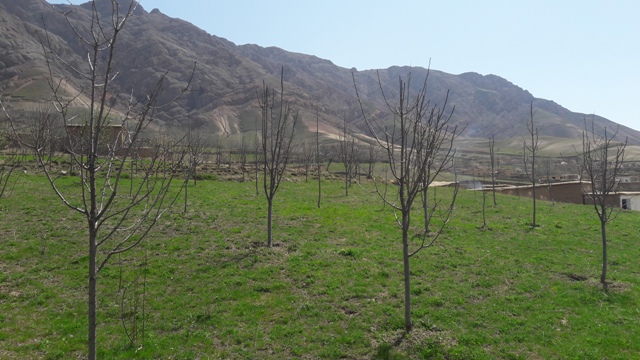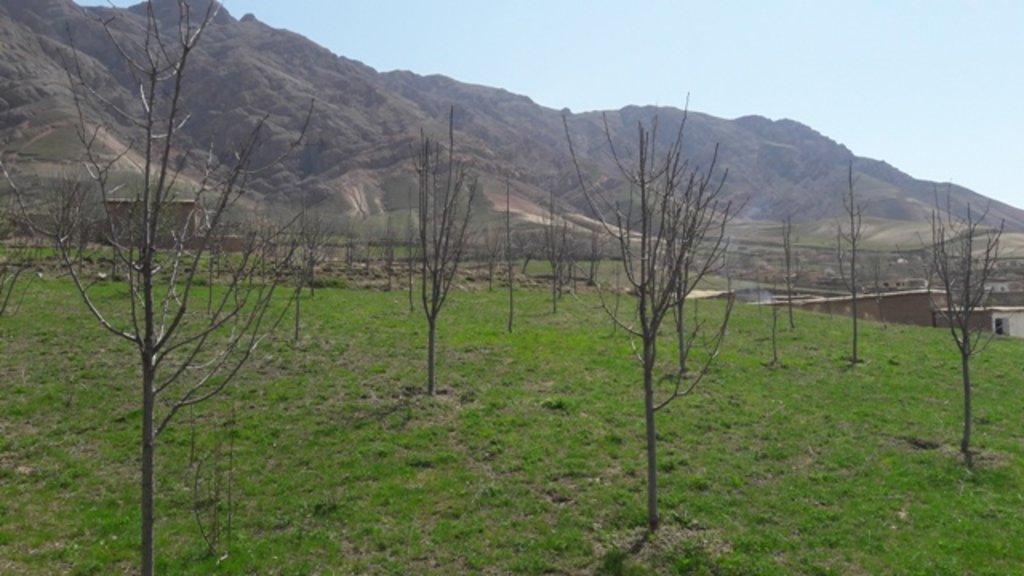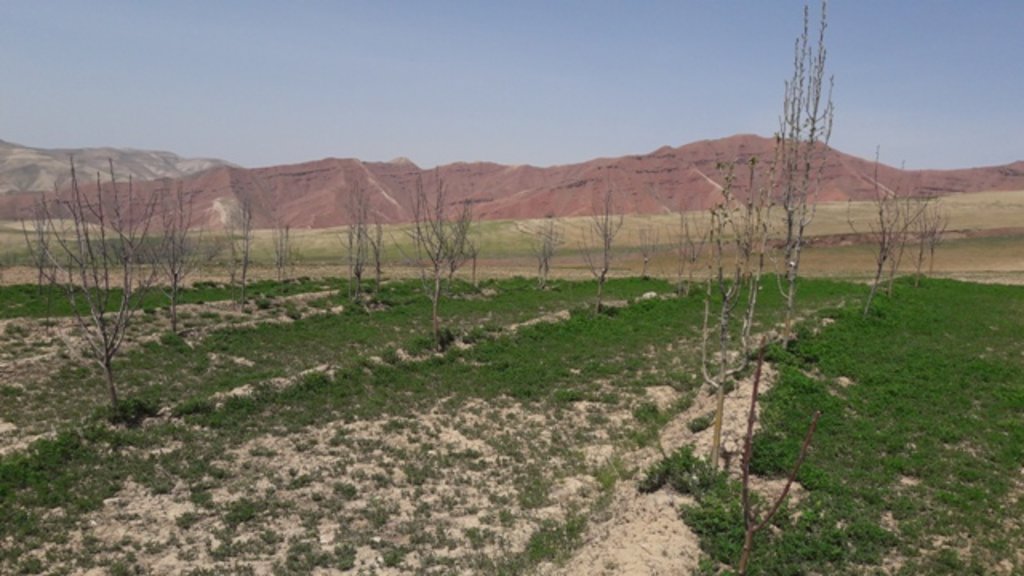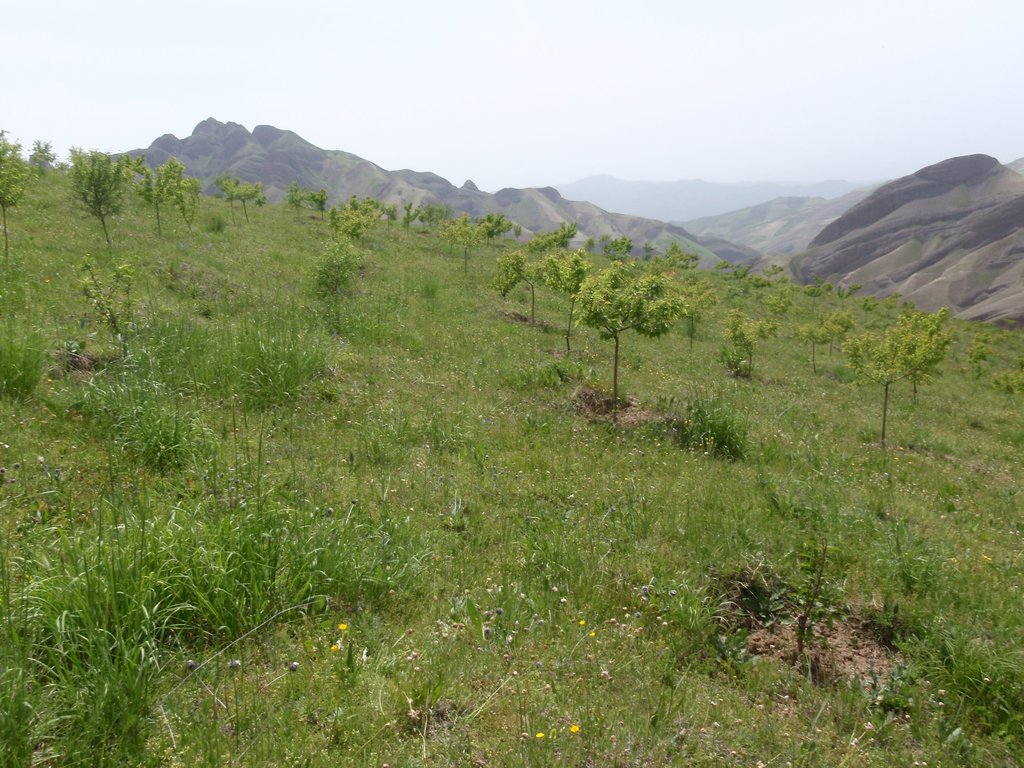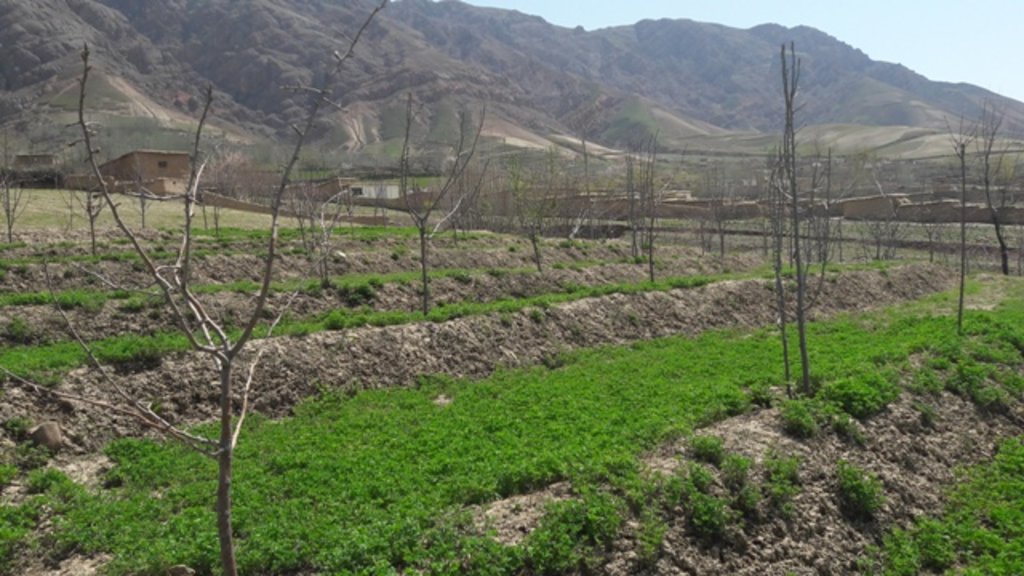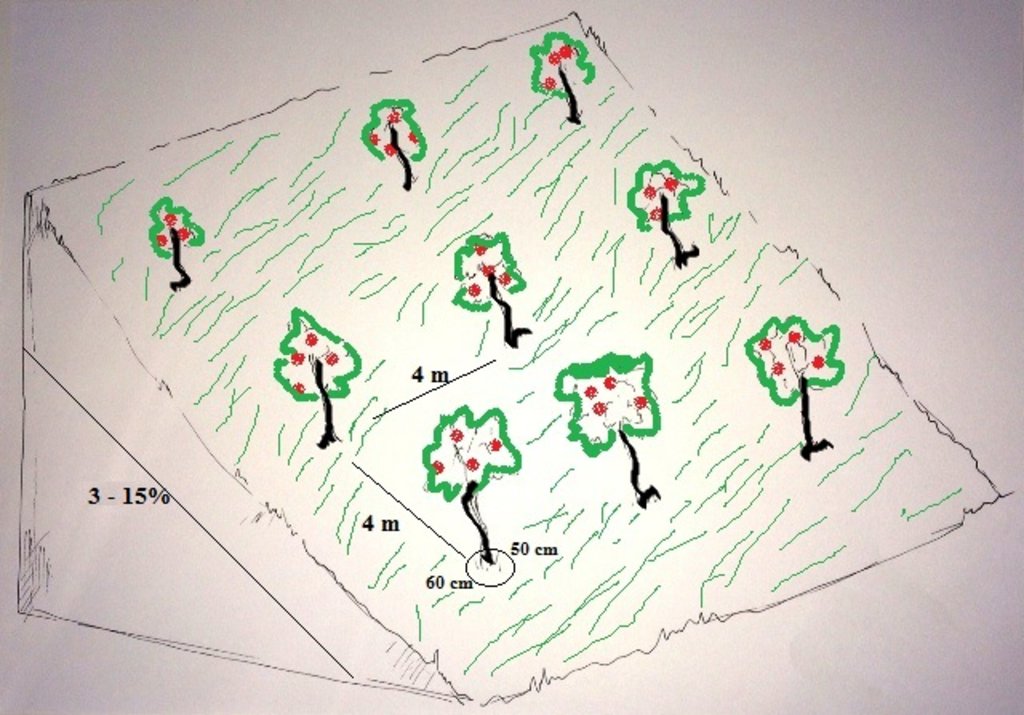Establishment of improved orchards and vineyards [ប្រទេសអាហ្វហ្គានិស្ថាន]
- ការបង្កើត៖
- បច្ចុប្បន្នភាព
- អ្នកចងក្រង៖ Bettina Wolfgramm
- អ្នកកែសម្រួល៖ Roziya Kirgizbekova
- អ្នកត្រួតពិនិត្យ Rima Mekdaschi Studer
Bunyodi boghi va boghi anguri behbudyofta
technologies_669 - ប្រទេសអាហ្វហ្គានិស្ថាន
ពិនិត្យមើលគ្រប់ផ្នែក
ពង្រីកមើលទាំងអស់ បង្រួមទាំងអស់1. ព័ត៌មានទូទៅ
1.2 ព័ត៌មានលម្អិតពីបុគ្គលសំខាន់ៗ និងស្ថាប័នដែលចូលរួមក្នុងការវាយតម្លៃ និងចងក្រងឯកសារនៃបច្ចេកទេស
បុគ្គលសំខាន់ម្នាក់ (ច្រើននាក់)
អ្នកប្រើប្រាស់ដី:
Mirza Bay Gholam Sakhi
Natural Resources Management Comittee (NRMC)
ប្រទេសអាហ្វហ្គានិស្ថាន
អ្នកជំនាញឯកទេស SLM:
អ្នកជំនាញឯកទេស SLM:
Researcher:
ឈ្មោះគម្រោងដែលបានចងក្រងឯកសារ/ វាយតម្លៃលើបច្ចេកទេស (បើទាក់ទង)
Livelihood Improvement Project Takhar, Afghanistan (LIPT)ឈ្មោះគម្រោងដែលបានចងក្រងឯកសារ/ វាយតម្លៃលើបច្ចេកទេស (បើទាក់ទង)
Potential and limitations for improved natural resource management (NRM) in mountain communities in the Rustaq district, Afghanistan (Rustaq NRM Study)ឈ្មោះអង្គភាពមួយ (ច្រើន) ដែលបានចងក្រងឯកសារ/ វាយតម្លៃបច្ចេកទេស (បើទាក់ទង)
Terre des Hommes (Terre des Hommes) - ប្រទេសស្វ៊ីសឈ្មោះអង្គភាពមួយ (ច្រើន) ដែលបានចងក្រងឯកសារ/ វាយតម្លៃបច្ចេកទេស (បើទាក់ទង)
Swiss Agency for Development and Cooperation (DEZA / COSUDE / DDC / SDC) - ប្រទេសស្វ៊ីសឈ្មោះអង្គភាពមួយ (ច្រើន) ដែលបានចងក្រងឯកសារ/ វាយតម្លៃបច្ចេកទេស (បើទាក់ទង)
Bern University of Applied Sciences, School of Agricultural, Forest and Food Sciences (HAFL) - ប្រទេសស្វ៊ីសឈ្មោះអង្គភាពមួយ (ច្រើន) ដែលបានចងក្រងឯកសារ/ វាយតម្លៃបច្ចេកទេស (បើទាក់ទង)
CDE Centre for Development and Environment (CDE Centre for Development and Environment) - ប្រទេសស្វ៊ីស1.3 លក្ខខណ្ឌទាក់ទងទៅនឹងការប្រើប្រាស់ទិន្នន័យដែលបានចងក្រងតាមរយៈ វ៉ូខេត
អ្នកចងក្រង និង(បុគ្គលសំខាន់ៗ)យល់ព្រមទទួលយកនូវលក្ខខណ្ឌនានាទាក់ទងទៅនឹងការប្រើប្រាស់ទិន្នន័យដែលបានចងក្រងតាមរយៈវ៉ូខេត:
បាទ/ចា៎
1.4 សេចក្តីប្រកាសស្តីពីចីរភាពនៃការពណ៌នាពីបច្ចេកទេស
តើបច្ចេកទេសដែលបានពណ៌នានេះមានបញ្ហាដែលផ្តោតលើការធ្លាក់ចុះគុណភាពដី, បើដូច្នេះវាមិនអាចត្រូវបានប្រកាសថាជាបច្ចេកទេសនៃការគ្រប់គ្រងប្រកបដោយចីរភាពទេ?
ទេ
មតិយោបល់:
SLM practices documented in the frame of the Rustaq NRM study were established only recently (1-3 years ago). It is too early for a final judgment on the sustainability of these technologies within the human and natural environment of Chokar watershed.
2. ការពណ៌នាពីបច្ចេកទេស SLM
2.1 ការពណ៌នាដោយសង្ខេបពីបច្ចេកទេស
និយមន័យបច្ចេកទេស:
Local and new varieties of fruits are planted on degraded land in accordance with improved management practices. The established orchards and vineyards serve double purpose of soil protection and income generation for the rural households. The alfalfa under the trees supports tree growth and is used for livestock fodder.
2.2 ការពណ៌នាលម្អិតពីបច្ចេកទេស
ការពណ៌នា:
Project supported implementation of improved orchards and vineyards has taken place in the villages Sari Joy, Jawaz Khana and Dashti Mirzai, located in Chokar watershed of Rustaq District in Northern Afghanistan. The Chokar watershed is a mountainous area situated between 600 - 2,500 m above sea level. The climate is semi-arid with harsh and cold weather in winter and hot and dry summers. The annual precipitation in average years is 580mm. Land degradation affects all forms of land use and includes low vegetation cover, heavy top soil erosion from water, and poor soil fertility. Unsustainable agricultural practices, over-exploitation and high pressure on the natural resources are adversely impacting on the socio-economic well-being of local communities as well as contributing to the risk for being adversely affected by drought as well as landslides and flash foods triggered by heavy rainfall. The data used for the documentation of the technology is based on field research conducted in Chokar watershed, namely in the villages: Sari Joy, Jawaz Khana and Dashti Mirzai. These villages represent the upper, the middle and the lower zone of Chokar watershed, respectively. They differ considerably in access to services and infrastructure, but in general are poorly served. The communities depend on land resources for sustaining their livelihoods. In a good year with high yields, wheat-self-sufficiency lasts about 5 months. The three villages are home to ethnic Qarluq communities. Since 2012 the Livelihood Improvement Project Takhar (LIPT) implemented by Terre des hommes (Tdh) Switzerland has initiated a range of NRM interventions.
The rural population in Rustaq district of Afghanistan traditionally grows local varieties of apples, pears and grapes. Mostly it is subsistence farming with a small-scale local marketing. Shortage of irrigation water and lack of specific knowledge about horticultural and viticulture practices, negatively affects fruit yields. Apart of providing diverse fruits for consumption, orchards are also important for providing fodder for the livestock, retaining soil moisture and protecting the soil from erosion.
The local land users interested in the establishment of improved orchards and vineyards were mobilized through the Natural Resources Management Committees (NRMC) in Sari Joy, Jawaz Khana and Dashti Mirzai villages. In addition to the local varieties of pears, apples and grapes, new improved varieties were used for orchards and vineyards on 6.5 ha of degraded land. Such orchards were established inside or close to the villages on mountain slopes with gentle (3-5%) and moderate (6 -15%) steepness. Fruit trees are planted on locally identified dark and light soils, which correspond to moderately deep and loamy soil of medium soil fertility. Considering the medium quality of the soil, the first step of tree plantation is application of organic fertilizer. Afterwards, the plot is designed according to 4m x 4 m spacing between the trees. Under such parameters, on 1 jirib (0.2 ha) of land 125 fruit tree (apple or pear) seedlings are planted. The depth of the planting pits is 60 x 50 cm. The planted tree is watered and the lower trunk is covered with lime and water solution. Alfalfa is sown under the trees to serve as a fodder for the livestock. The orchards are irrigated mostly during summer once a week. In areas where there is shortage of irrigation water the trees are rainfed. Other maintenance activities include pest and disease control provided by a trained local specialist.
The new orchards only recently started giving fruits. The actual fruit yields are expected in 2017-2018. Expected higher yields of improved verities of pears, apples and grapes serves as a strong incentive for the local land users and their families to establish and maintain the orchards. Orchards are very demanding, but their reward is very promising in terms of improved harvest and more opportunities to sell the produce. Some land users have successful experience on their plots and already have fruits in their gardens and plan to enlarge their garden and plant more varieties of fruit trees, such as persimmons. Alfalfa which grows under the trees has important production value, particularly during the early years after the establishment phase, when the trees are too young to give fruits.
Female members of the households, which implemented orchards are also involved in establishing and maintaining orchards and vineyards. They take part in planting trees, watering, hay making and protecting the trees from livestock and people. Their contribution, plays an important part for the successful implementation of improved orchards and vineyards in Sari Joy, Jawaz Khana and Dashti Mirzai.
2.3 រូបភាពនៃបច្ចេកទេស
2.5 ប្រទេស/តំបន់/ទីតាំងកន្លែង ដែលបច្ចេកទេសត្រូវបានអនុវត្ត និងបានគ្រប់ដណ្តប់ដោយការវាយតម្លៃនេះ
ប្រទេស:
ប្រទេសអាហ្វហ្គានិស្ថាន
តំបន់/រដ្ឋ/ខេត្ត:
Takhar Province, Rustaq District
បញ្ជាក់បន្ថែមពីលក្ខណៈនៃទីតាំង:
Sari Joy, Jawaz Khana, Dashti Mirzai
បញ្ជាក់ពីការសាយភាយនៃបច្ចេកទេស:
- ត្រូវបានផ្សព្វផ្សាយត្រឹមតំបន់មួយ
ប្រសិនបើមិនច្បាស់ពីទំហំផ្ទៃដី សូមធ្វើការប៉ាន់ប្រម៉ាណ:
- < 0.1 គម2 (10 ហិកតា)
មតិយោបល់:
This documentation is based on the experiences of SLM implementers from Sari Joy (8 plots), Jawaz Khana, (6 plots), and Dashti Mirzai (3 plots). Additionally insights were gained through interviews with both SLM implementers and observers from all three villages.
Map
×2.6 កាលបរិច្ឆេទនៃការអនុវត្ត
ប្រសិនបើមិនច្បាស់ឆ្នាំ សូមបញ្ជាក់កាលបរិច្ឆេទដែលប្រហាក់ប្រហែល:
- តិចជាង 10ឆ្នាំមុន (ថ្មី)
2.7 ការណែនាំពីបច្ចេកទេស
សូមបញ្ជាក់តើបច្ចេកទេសត្រូវបានណែនាំឱ្យអនុវត្តដោយរបៀបណា:
- តាមរយៈគម្រោង / អន្តរាគមន៍ពីខាងក្រៅ
មតិយោបល់ (ប្រភេទនៃគម្រោង ។ល។):
Livelihood Improvement Project Takhar (LIPT) supported by Swiss Development Cooperation (SDC) from 2012-17
3. ចំណាត់ថ្នាក់នៃបច្ចេកទេស SLM
3.1 គោលបំណងចម្បង (១ ឬច្រើន) នៃបច្ចេកទេសនេះ
- ធ្វើឱ្យប្រសើរឡើងនូវផលិតកម្ម
3.2 ប្រភេទដីប្រើប្រាស់មួយប្រភេទ (ច្រើនប្រភេទ) ដែលបានអនុវត្តបច្ចេកទេស
ដីប្រើប្រាស់ចម្រុះនៅលើដីតែមួយ:
បាទ/ចា៎
បញ្ជាក់ពីប្រភេទដីច្រើនប្រភេទ (ដីដាំដំណាំ/ដីចិញ្ចឹមសត្វ/ដីព្រៃឈើ):
- ដាំដំណាំ ចិញ្ចឹមសត្វ និងឈើ

ដីដាំដំណាំ
- ដំណាំប្រចាំឆ្នាំ
- ដំណាំរយៈពេលវែង (មិនមែនឈើ)
- ប្រភេទដើមឈើធំៗ និងដើមឈើតូចៗ
ដំណាំប្រចាំឆ្នាំ - បញ្ជាក់ប្រភេទដំណាំ:
- ដំណាំចំណីសត្វ - alfalfa
ប្រភេទដើមឈើធំៗ និងដើមឈើតូចៗ - បញ្ជាក់ប្រភេទ:
- ដំណាំចំណី (Calliandra, Leucaena leucocephala, Prosopis, etc.)
- ទំពាំងបាយជូ
- ផ្លែប៉ោម (ប៉ោម សារី ។ល។)
- ដើមឈើយកគ្រាប់ (brazil nuts, pistachio, walnuts, almonds, etc.)
ចំនួនសារដែលដាំដំណាំក្នុងមួយឆ្នាំ:
- 1

ដីសម្រាប់ចិញ្ចឹមសត្វ

ដីព្រៃ/ដីដាំដើមឈើ
3.3 បន្ទាប់ពីអនុវត្តបច្ចេកទេស តើដីប្រើប្រាស់មានការប្រែប្រួលដែររឺទេ?
បន្ទាប់ពីអនុវត្តបច្ចេកទេស តើដីប្រើប្រាស់មានការប្រែប្រួលដែររឺទេ?
- បាទ/ច៎ា (សូមបំពេញសំណួរខាងក្រោមពីស្ថានភាពដីប្រើប្រាស់មុនពេលអនុវត្តបច្ចេកទេស)

ដីដាំដំណាំ
មតិយោបល់:
About half of orchard plots are established on cropland.
3.4 ការផ្គត់ផ្គង់ទឹក
ការផ្គត់ផ្គង់ទឹកនៅកន្លែងអនុវត្តបច្ចេកទេស:
- ទឹកភ្លៀង និងប្រព័ន្ធស្រោចស្រព
មតិយោបល់:
Often the trees are watered with supplementary irrigation, from irrigation channels, or fetching the water in buckets.
3.5 ក្រុម SLM ដែលបច្ចេកទេសស្ថិតនៅក្នុង
- កសិរុក្ខកម្ម
3.6 វិធានការ SLM ដែលបញ្ចូលនូវបច្ចេកទេស

វិធានការរុក្ខជាតិ
- V1: ឈើធំៗ និងដើមឈើតូចៗ
- V2: ស្មៅនិងរុក្ខជាតិៗដែលដុះមានអាយុមិនលើសពី 2ឆ្នាំ

វិធានការគ្រប់គ្រង
- M1: ការផ្លាស់ប្តូរប្រភេទដីប្រើប្រាស់
មតិយោបល់:
Many land users establish a fence around their orchards to protect the trees from animal and the fruits from theft.
3.7 កំណត់ប្រភេទនៃការធ្លាក់ចុះគុណភាពដីសំខាន់ៗដែលបច្ចេកទេសនេះបានដោះស្រាយ

ការហូរច្រោះដីដោយសារទឹក
- Wt: ការបាត់ដីស្រទាប់លើដោយការហូរច្រោះ

ការបាត់ដីដោយសារខ្យល់
- Et: ការបាត់បង់ដីស្រទាប់លើ

ការធ្លាក់ចុះជីវសាស្ត្រនៃដី
- Bc: ការថយចុះនូវគម្របរុក្ខជាតិ
- Bq: ការថយចុះនូវជីវម៉ាស/ បរិមាណ

ការបាត់បង់ទឹក
- Ha: ការថយចុះសំណើមដី
3.8 ការពារ កាត់បន្ថយ ឬស្តារឡើងវិញនៃការធ្លាក់ចុះគុណភាពដី
បញ្ជាក់ពីគោលដៅរបស់បច្ចេកទេស ដែលផ្តោតទៅការធ្លាក់ចុះគុណភាពដី:
- ការការពារការធ្លាក់ចុះគុណភាពដី
- ការកាត់បន្ថយការធ្លាក់ចុះគុណភាពដី
4. បច្ចេកទេសជាក់លាក់ សកម្មភាពអនុវត្ត ធាតុចូល និងថ្លៃដើម
4.1 គំនូសបច្ចេកទេសនៃបច្ចេកទេសនេះ
លក្ខណៈពិសេសនៃបច្ចេកទេស (ទាក់ទងនឺងគំនូរបច្ចេកទេស):
Orchards are established on mountain slopes with gentle (3-5%) and moderate (6-10%) steepness. Considering the medium soil fertility, the first step of tree plantation is application of organic fertilizer. Afterwards, the plot is designed according to 4m x 4 m spacing between rows and trees. Under such parameters, on 1 jirib (0.2 ha) of land 125 fruit tree (apple or pear) seedlings are planted. The depth of the planting pits is 60 x 50 cm. The planted tree is watered and the lower trunk is covered with lime and water solution. Alfalfa is sown under the trees for livestock fodder.
ឈ្មោះអ្នកនិពន្ធ:
Aslam Qadamov; Roziya Kirgizbekova
កាលបរិច្ឆេទ:
03/04/2017
4.2 ព័ត៌មានទូទៅដែលពាក់ព័ន្ធនឹងការគណនាធាតុចូល និងថ្លៃដើម
កំណត់របៀបនៃការគណនាថ្លៃដើម និងធាតុចូល:
- ក្នុងតំបន់អនុវត្តបច្ចេកទេស
កំណត់ទំហំ និងឯកត្តាផ្ទៃដី:
1 ha
កំណត់រូបិយប័ណ្ណសម្រាប់ថ្លៃដើម:
- ដុល្លារ
បើពាក់ព័ន្ធសូមកំណត់អត្រាប្តូរប្រាក់ពីដុល្លាទៅរូបិយប័ណ្ណតំបន់ (ឧ. 1 ដុល្លារ = 79.9 រៀលនៃរូបិយប័ណ្ណប្រេស៊ីល) ៖ 1 ដុល្លារ =:
67,0
កំណត់ថ្លៃឈ្នួលជាមធ្យមនៃការជួលកម្លាំងពលកម្មក្នុងមួយថ្ងៃ:
5.2-5.3 USD per day
4.3 សកម្មភាពបង្កើត
| សកម្មភាព | រយៈពេល (រដូវកាល) | |
|---|---|---|
| 1. | Selection of the area for orchard (Men) | Fall |
| 2. | Applicatoin of manure (Men) | Fall/Winter |
| 3. | Design of tree spacing in the orchard assisted by project staff (Men) | End of winter |
| 4. | Digging pits for planting (Men/Women) | Spring |
| 5. | Planting of fruit trees (Men/Women) | Spring |
| 6. | Sowing of alfalfa under the trees (Men/Women) | Spring |
4.4 ថ្លៃដើម និងធាតុចូលដែលត្រូវការសម្រាប់ការបង្កើតបច្ចេកទេស
| បញ្ជាក់ពីធាតុចូល | ឯកតា | បរិមាណ | ថ្លៃដើមក្នុងមួយឯកតា | ថ្លៃធាតុចូលសរុប | % នៃថ្លៃដើមដែលចំណាយដោយអ្នកប្រើប្រាស់ដី | |
|---|---|---|---|---|---|---|
| កម្លាំងពលកម្ម | Application of manure | person-day | 5,0 | 5,3 | 26,5 | 83,0 |
| កម្លាំងពលកម្ម | Design of tree spacing | person-day | 5,0 | 5,3 | 26,5 | |
| កម្លាំងពលកម្ម | Digging pits for planting | person-day | 15,0 | 5,3 | 79,5 | 83,0 |
| កម្លាំងពលកម្ម | Planting trees, sowing alfalfa and watering | person-day | 10,0 | 5,3 | 53,0 | 83,0 |
| សម្ភារៈ | Meter | piece | 1,0 | 2,25 | 2,25 | |
| សម្ភារៈ | Rope | Meter | 500,0 | 0,07 | 35,0 | |
| សម្ភារៈ | Shovel | piece | 2,0 | 3,8 | 7,6 | |
| សម្ភារៈ | Pick axe | piece | 1,0 | 2,25 | 2,25 | |
| សម្ភារៈដាំដុះ | Seedlings (apple/pear) | piece | 625,0 | 0,75 | 468,75 | |
| សម្ភារៈដាំដុះ | Alfalfa seeds | kg | 17,5 | 0,42 | 7,35 | |
| ជី និងសារធាតុពុល | DAP | Kg | 250,0 | 0,9 | 225,0 | |
| ជី និងសារធាតុពុល | Urea | Kg | 250,0 | 0,45 | 112,5 | |
| ជី និងសារធាតុពុល | Animal manure | ton | 10,0 | 60,0 | 600,0 | |
| ជី និងសារធាតុពុល | Pesticide | cc | 500,0 | 0,9 | 450,0 | |
| ជី និងសារធាតុពុល | Lime | Kg | 25,0 | 1,5 | 37,5 | |
| ថ្លៃដើមសរុបក្នុងការបង្កើតបច្ចេកទេស | 2133,7 | |||||
| ថ្លៃដើមសរុបក្នុងការបង្កើតបច្ចេកទេសគិតជាដុល្លារ | 31,85 | |||||
ប្រសិនបើអ្នកប្រើប្រាស់ដីមិនមានថ្លៃដើម 100% សូមបញ្ជាក់ថានរណាដែលចំណាយថ្លៃដើមដែលនៅសល់:
Livelihood Improvement Project Takhar (LIPT) implemented by Terre des hommes (Tdh) Switzerland
មតិយោបល់:
Costs calculated for a Technology area of 1ha was only done for the purpose of the WOCAT documentation. In reality SLM plots are on average 0.2- 0.4 ha or 1- 2 jiribs. Costs were simply multiplied by 5. The actual costs for a 1ha plot might be slightly different.
4.5 សកម្មភាពថែទាំ
| សកម្មភាព | ពេលវេលា/ ភាពញឹកញាប់ | |
|---|---|---|
| 1. | Watering of the trees (Men/Women) | 2 times/month/Summer |
| 2. | Weeding (Women) | |
| 3. | Pruning (Men) | |
| 4. | Lime application (Men) | |
| 5. | Hay making (Men/Women) | |
| 6. | Harvesting fruits (Men/Women) |
4.6 កំណត់ថ្លៃដើមសម្រាប់ការថែទាំ/ សកម្មភាពរបស់បច្ចេកទេស (ក្នុងរយៈពេលមួយឆ្នាំ)
| បញ្ជាក់ពីធាតុចូល | ឯកតា | បរិមាណ | ថ្លៃដើមក្នុងមួយឯកតា | ថ្លៃធាតុចូលសរុប | % នៃថ្លៃដើមដែលចំណាយដោយអ្នកប្រើប្រាស់ដី | |
|---|---|---|---|---|---|---|
| កម្លាំងពលកម្ម | Irrigation | person day | 5,0 | 5,3 | 26,5 | 100,0 |
| កម្លាំងពលកម្ម | Weeding | person day | 5,0 | 5,3 | 26,5 | 100,0 |
| កម្លាំងពលកម្ម | Pruning | person day | 5,0 | 5,3 | 26,5 | 100,0 |
| កម្លាំងពលកម្ម | Lime application | person day | 5,0 | 5,3 | 26,5 | 100,0 |
| សម្ភារៈ | Scissors for pruning | piece | 2,0 | 9,0 | 18,0 | |
| ជី និងសារធាតុពុល | Lime | Kg | 25,0 | 1,5 | 37,5 | 100,0 |
| ថ្លៃដើមសរុបសម្រាប់ការថែទាំដំណាំតាមបច្ចេកទេស | 161,5 | |||||
| ថ្លៃដើមសរុបសម្រាប់ការថែទាំដំណាំតាមបច្ចេកទេសគិតជាដុល្លារ | 2,41 | |||||
ប្រសិនបើអ្នកប្រើប្រាស់ដីមិនមានថ្លៃដើម 100% សូមបញ្ជាក់ថានរណាដែលចំណាយថ្លៃដើមដែលនៅសល់:
Livelihood Improvement Project Takhar (LIPT) implemented by Terre des Hommes (Tdh) Switzerland
មតិយោបល់:
Costs calculated for a Technology area of 1ha was only done for the purpose of the WOCAT documentation. In reality SLM plots are on average 0.2- 0.4 ha or 1- 2 jiribs. Costs were simply multiplied by 5. The actual costs for a 1ha plot might be slightly different.
4.7 កត្តាសំខាន់បំផុតដែលមានឥទ្ធិពលដល់ការចំណាយ
ពណ៌នាពីកត្តាប៉ះពាល់ចម្បងៗទៅលើថ្លៃដើម:
Due to the remoteness of the villages where the Technology has been implemented, all the inputs for establishment, such as agricultural equipment, plant material, fertilizers, etc., are purchased in Rustaq town. The expenses for traveling and delivering the inputs affect the establishment costs.
5. លក្ខណៈបរិស្ថានធម្មជាតិ និងមនុស្ស
5.1 អាកាសធាតុ
បរិមាណទឹកភ្លៀងប្រចាំឆ្នាំ
- < 250 មម
- 251-500 មម
- 501-750 មម
- 751-1,000 មម
- 1,001-1,500 មម
- 1,501-2,000 មម
- 2,001-3,000 មម
- 3,001-4,000 មម
- > 4,000 មម
កំណត់បរិមាណទឹកភ្លៀង (បើដឹង) ជា មីលីម៉ែត្រ:
580,00
លក្ខណៈពិសេស/ មតិយោបល់លើរដូវភ្លៀង:
Average annual percipitation for the area was calculated with 580 mm, with minimums in dry years (2000 and 2001) of 270 mm and maximums in wet years (2009/2010) of 830 mm. The absolut maximum rainfall was calculated for 1986 with 1024 mm. The data series covers the time from 1979 to 2014.
បញ្ជាក់ឈ្មោះឯកសារយោងនៃស្ថានីយឧតុនិយម:
Climate Forecast System Reanalysis (CFSR), http://rda.ucar.edu/pub/cfsr.html
តំបន់កសិអាកាសធាតុ
- មានភ្លៀងតិចតួច
Derived from the publicly available dataset on length of growing period (LGP) (Fischer 2009 / IIASA-FAO). Internet link: http://tiles.arcgis.com/tiles/P8Cok4qAP1sTVE59/arcgis/rest/services/Length_of_growing_period/MapServer
5.2 សណ្ឋានដី
ជម្រាលជាមធ្យម:
- រាបស្មើ (0-2%)
- ជម្រាលតិចតួច (3-5%)
- មធ្យម (6-10%)
- ជម្រាលខ្ពស់បន្តិច (11-15%)
- ទីទួល (16-30%)
- ទីទួលចោត (31-60%)
- ទីទួលចោតខ្លាំង (>60%)
ទម្រង់ដី:
- ខ្ពង់រាប
- កំពូលភ្នំ
- ជម្រាលភ្នំ
- ជម្រាលទួល
- ជម្រាលជើងភ្នំ
- បាតជ្រលងភ្នំ
តំបន់តាមរយៈកម្ពស់ :
- 0-100 ម
- 101-500 ម
- 501-1,000 ម
- 1,001-1,500 ម
- 1,501-2,000 ម
- 2,001-2,500 ម
- 2,501-3,000 ម
- 3,001-4,000 ម
- > 4,000 ម
5.3 ដី
ជម្រៅដីជាមធ្យម:
- រាក់ខ្លាំង (0-20 សម)
- រាក់ (21-50 សម)
- មធ្យម (51-80 សម)
- ជ្រៅ (81-120 សម)
- ជ្រៅខ្លាំង (> 120 សម)
វាយនភាពដី (ស្រទាប់លើ):
- មធ្យម (ល្បាយ, ល្បាប់)
វាយនភាពដី (> 20 សម ស្រទាប់ក្នុង):
- មធ្យម (ល្បាយ, ល្បាប់)
សារធាតុសរីរាង្គនៅស្រទាប់ដីខាងលើ:
- មធ្យម (1-3%)
- ទាប (<1%)
បើអាចសូមភ្ជាប់ការពណ៌នាពីដីឱ្យបានច្បាស់ ឬព័ត៌មានដែលអាចទទួលបាន ឧ. ប្រភេទដី, pH ដី/ ជាតិអាស៊ីត, សមត្ថភាពផ្លាស់ប្តូរកាចុង, វត្តមាននីត្រូសែន, ភាពប្រៃ ។ល។:
Local land users differentiate between the following soil types where orchards and vineyards are established:
- Light soil: moderately deep; texture medium; medium, low organic matter
- Dark soil: moderately deep; texture medium, medium; medium organic matter
5.4 ទឹកដែលអាចទាញមកប្រើប្រាស់បាន និងគុណភាពទឹក
នីវ៉ូទឹកក្រោមដី:
5-50 ម
ទឹកលើដីដែលអាចទាញយកប្រើប្រាស់បាន:
កម្រិតមធ្យម
គុណភាពទឹក (មិនបានធ្វើប្រត្តិកម្ម):
ទឹកពិសារដែលមានគុណភាពល្អ
តើមានបញ្ហាភាពទឹកប្រៃហូរចូលមកដែរឬទេ?
ទេ
តើទឹកជំនន់កំពុងកើតមាននៅតំបន់នេះដែររឺទេ?
បាទ/ចា៎
ភាពទៀងទាត់:
ម្តងម្កាល
មតិយោបល់ និងលក្ខណៈពិសេសផ្សេងៗទៀតលើគុណភាព និងបរិមាណទឹក :
Floods occur mainly during the rainy seasons in spring and autumn. Availability of surface water differs for the three study villages Sari Joy, Jawaz Khana, and Dashti Mirzai. Sari Joy has sources and good surface water availability. Jawaz Khana has poor water availability as water has to be fetched from a lower laying stream. Dashti Mirzai has good water availability also from an irrigation channel.
5.5 ជីវៈចម្រុះ
ភាពសម្បូរបែបនៃប្រភេទ:
- ទាប
ភាពសម្បូរបែបនៃទីជម្រក:
- ទាប
5.6 លក្ខណៈនៃអ្នកប្រើប្រាស់ដីដែលអនុវត្តបច្ចេកទេស
នៅមួយកន្លែង ឬពនេចរ :
- នៅមួយកន្លែង
ទីផ្សារនៃប្រព័ន្ធផលិតកម្ម:
- សម្រាប់ហូបក្នុងគ្រួសារ (ផ្គត់ផ្គង់ខ្លួនឯង)
- ពាក់កណ្តាលពាណិជ្ជកម្ម (ផ្គត់ផ្គង់ខ្លួនឯង/ ពាណិជ្ជកម្ម)
ចំណូលក្រៅកសិកម្ម:
- 10-50% នៃចំណូល
- ច្រើនជាង 50% នៃចំណូល
កម្រិតជីវភាព:
- មធ្យម
- មាន
ឯកជន ឬក្រុម:
- ធ្វើខ្លួនឯង/ គ្រួសារ
កម្រិតប្រើប្រាស់គ្រឿងយន្ត:
- ប្រើកម្លាំងពលកម្ម
យេនឌ័រ:
- ស្ត្រី
- បុរស
អាយុរបស់អ្នកប្រើប្រាស់ដី:
- វ័យកណ្តាល
- មនុស្សចាស់
សូមបញ្ជាក់ពីលក្ខណៈពាក់ព័ន្ធផ្សេងទៀតអំពីអ្នកប្រើប្រាស់ដី:
The land users in the area where the Technology is applied belong to the Uzbek ethnic minority group Qarluq.
Although the men are generally the main land users, however, women and children also take active part in the related work. The functions of men and women are clearly distinguished within the Afghan society. At the same time within the family this division of work and functions also results in men and women working hand-in-hand. An improvement of the family’s livelihood situation is expected to positively affect all family members. While, it is recognized that the involvement of women is key in order to secure basic human rights for everyone, to achieve good governance, sustainable development, and to efficiently contribute to poverty reduction (SDC 2004), it is also clear that a context sensitive approach is of high importance.
Women in rural Afghanistan are involved in many production and income generating activities that contribute to the overall household income, however, very few women own resources such as land and livestock, and their income generating options are fewer in comparison to that of men.
5.7 ទំហំផ្ទៃដីជាមធ្យមនៃដីប្រើប្រាស់ដោយអ្នកប្រើប្រាស់ដី ក្នុងការអនុវត្តបច្ចេកទេស
- < 0.5 ហិកតា
- 0.5-1 ហិកតា
- 1-2 ហិកតា
- 2-5 ហិកតា
- 5-15 ហិកតា
- 15-50 ហិកតា
- 50-100 ហិកតា
- 100-500 ហិកតា
- 500-1,000 ហិកតា
- 1,000-10,000 ហិកតា
- > 10,000 ហិកតា
តើផ្ទៃដីនេះចាត់ទុកជាទំហំកម្រិតណាដែរ ខ្នាតតូច មធ្យម ឬខ្នាតធំ (ធៀបនឹងបរិបទតំបន់)?
- ខ្នាតមធ្យម
5.8 ភាពជាម្ចាស់ដី កម្មសិទ្ធប្រើប្រាស់ដី និងកម្មសិទ្ធប្រើប្រាស់ទឹក
ភាពជាម្ចាស់ដី:
- ឯកជន មិនមានកម្មសិទ្ធ
កម្មសិទ្ធិប្រើប្រាស់ដី:
- ឯកជន
កម្មសិទ្ធប្រើប្រាស់ទឹក:
- ជាក្រុម (មានដែនកំណត់)
មតិយោបល់:
Those who own land and use water for irrigation are obliged to pay for the water. The payment is made both in kind and in cash to the Mirob - the person in charge of distributing water in the community. The amount of the payment varies from village to village.
6. ផលប៉ះពាល់ និងការសន្និដ្ឋាន
6.1 ផលប៉ះពាល់ក្នុងបរិវេណអនុវត្តបច្ចេកទេសដែលកើតមាន
ផលប៉ះពាល់លើសេដ្ឋកិច្ចសង្គម
ផលិតផល
ផលិតកម្មដំណាំ
មតិយោបល់/ ការបញ្ជាក់:
The local and new improved varieties of fruit trees planted and managed sustainably give better fruit yields. Enhanced fruit production is also due to proper and timely control of pests and disease.
ផលិតកម្មចំណីសត្វ
មតិយោបល់/ ការបញ្ជាក់:
The grass (alfalfa and sainfoin), which is planted under the fruit trees is used as fodder for livestock.
ផលិតកម្មសត្វ
មតិយោបល់/ ការបញ្ជាក់:
Indirect contribution to animal production is achieved through availability of more fodder for the livestock from the grass in the orchards. Animals also feed on the tree leaves in autumn.
ផលិតកម្មឈើ
មតិយោបល់/ ការបញ្ជាក់:
Production of wood is limited. Fuel wood is made from seasonal pruning of the trees.
អនុផលព្រៃឈើ
ភាពសម្បូរបែបនៃផលិតផល
មតិយោបល់/ ការបញ្ជាក់:
Multiple varieties of fruit trees are grown, also through grafting techniques.
ផ្ទៃដីផលិតកម្ម
ផលប៉ះពាល់ទៅលើវប្បធម៌សង្គម
សន្តិសុខស្បៀង/ ភាពគ្រប់គ្រាន់ខ្លួនឯង
មតិយោបល់/ ការបញ្ជាក់:
The new practice of establishing orchards and vineyards ensures better yields. New variety of fruits such as apples, pears, almonds and grapes improve the diversity of household's production and consumption. The households have better opportunity to earn more from selling their fresh and dried fruits on the local market.
ចំណេះដឹង SLM / ការធ្លាក់ចុះគុណភាពដី
មតិយោបល់/ ការបញ្ជាក់:
Land users learned new methods of planting trees according to the soil conditions and water availability. They were trained with such skills as grafting, pruning, pest and disease control and were introduced to improved verities of fruit trees.
ស្ថានភាពក្រុមដែលមានបញ្ហាក្នុងសង្គម និងសេដ្ឋកិច្ច
មតិយោបល់/ ការបញ្ជាក់:
Female headed households are not included. Technology is implemented on private land, therefore people without land are excluded. However, they have they opportunity to earn income as a hired worker for the SLM implementers.
ផលប៉ះពាល់ទៅលើអេកូឡូស៊ី
វដ្តទឹក/លំហូរ
លំហូរទឹកលើផ្ទៃដី
ដី
ការបាត់បង់ដី
ជីវចម្រុះ៖ ដំណាំ, សត្វ
ដំណាំគម្រប
មតិយោបល់/ ការបញ្ជាក់:
Improved vegetation cover resulting from the tree plantations and the grass.
6.2 ផលប៉ះពាល់ក្រៅបរិវេណអនុវត្តបច្ចេកទេសដែលកើតមាន
ទឹកជំនន់ខ្សែទឹកខាងក្រោម
កំណកល្បាប់ខ្សែទឹកខាងក្រោម
Buffering/សមត្ថភាពចម្រោះ
វាយតម្លៃផលប៉ះពាល់ក្រៅបរិវេណអនុវត្តបច្ចេកទេស (វាស់វែង):
These comments apply to 6.1 and 6.2:
- Socio-economic impacts: Individual SLM implementers were asked to rate the benefits from orchards and vineyards. They were asked to indicate production increase of crops; fodder; animals; wood; non-wood forest products; increase in product diversity; or production area. The most important increase they rated with 3, the second most with 2, others with 1 point. Averages of the points given by all implementers of orchards are reflected here.
- Similarly for the "ecological impacts" and on "off-site impacts": Individual SLM implementers were asked to rate the on-site and off-site impacts of orchards and vineyards on water; soil; and vegetation. They were asked to indicate the strength of impacts with three, two or one points. Averages of the points given by the orchard implementers are reflected here.
- Socio-cultural impacts: This section is answered by the scientists, based on information collected during focus group discussions, and interviews conducted with persons from the 3 villages where the LIPT project implemented the SLM practices.
6.3 ភាពប្រឈម និងភាពរួសនៃបច្ចេកទេសទៅនឹងការប្រែប្រួលអាកាសធាតុ និងគ្រោះអាកាសធាតុ/ គ្រោះមហន្តរាយ (ដែលដឹងដោយអ្នកប្រើប្រាស់ដី)
គ្រោះអាកាសធាតុ (មហន្តរាយ)
គ្រោះមហន្តរាយធម្មជាតិ
| លក្ខណៈឆ្លើយតបនៃបច្ចេកទេសទៅនឹងការប្រែប្រួលអាកាសធាតុ | |
|---|---|
| ព្យុះភ្លៀងតាមតំបន់ | ល្អណាស់ |
គ្រោះមហន្តរាយអាកាសធាតុ
| លក្ខណៈឆ្លើយតបនៃបច្ចេកទេសទៅនឹងការប្រែប្រួលអាកាសធាតុ | |
|---|---|
| រាំងស្ងួត | ល្អ |
មតិយោបល់:
Based on the multi-criteria matrix: SLM implementers were asked to jointly discuss and rate how much the SLM technology reduced the lands vulnerability to drought and local rainstorms. Only vulnerability to the most prevalent climate extremes (drought and local rainstorms) was discussed. SLM technologies were rated as reducing vulnerability poorly, well, or very well. The average points reflected here are from multi-criteria matrixes compiled in three villages where the SLM technology had been implemented.
6.4 ការវិភាគថ្លៃដើម និងអត្ថប្រយោជន៍
តើផលចំណេញ និងថ្លៃដើមត្រូវបានប្រៀបធៀបគ្នាយ៉ាងដូចម្តេច (ទស្សនៈរបស់អ្នកប្រើប្រាស់ដី)?
រយៈពេលខ្លី:
វិជ្ជមានខ្លាំង
រយៈពេលវែង:
វិជ្ជមានខ្លាំង
មតិយោបល់:
Based on the multi-criteria matrix: During the FGD with SLM implementers, a multi-criteria matrix was elaborated, and different SLM practices were rated. In the frame of this exercise, SLM implementers were asked to jointly discuss and rate short term (1-3 years) and long-term (10 years) returns of the SLM practice. As the SLM technology was only implemented 1-2 years ago, it is too early to compare benefits to maintenance costs. Farmers have little experience so far on the actual benefits of the SLM technology. The ratings are mostly based on expected benefits and not on actual benefits.
6.5 ការទទួលយកបច្ចេកទេស
- 1-10%
បើអាច សូមបញ្ជាក់ពីបរិមាណ (ចំនួនគ្រួសារ និង/ ឬតំបន់គ្របដណ្តប់):
6.5 ha
ក្នុងចំណោមគ្រួសារទាំងអស់ដែលបានអនុវត្តបច្ចេកទេស តើមានប៉ុន្មានគ្រួសារដែលចង់ធ្វើដោយខ្លួនឯង ដោយមិនទទួលបានសម្ភារៈលើកទឹកចិត្ត/ប្រាក់ឧបត្ថម្ភ?:
- 11-50%
មតិយោបល់:
Individual SLM implementers were asked whether they received support for implementing the Technology. Each indicated the type of support he received from the proposed options: "Full Support 100%, Some Support, No Support 0%". 18% have adopted the technology without receiving support.
6.6 ការបន្សុំា
តើថ្មីៗនេះ បច្ចេកទេសនេះត្រូវបានកែតម្រូវដើម្បីបន្ស៊ាំទៅនឹងស្ថានភាពប្រែប្រួលដែរឬទេ?
បាទ/ចា៎
ផ្សេងៗ (សូមបញ្ជាក់):
protection
បញ្ជាក់ពីការបន្ស៊ាំនៃបច្ចេកទេស (ការរៀបចំ, ឧបករណ៍/ប្រភេទ ។ល។):
Some of the land users built a wall around their orchard. The wall made from locally available clay material, protects the trees and the grass from animal and people intrusion.
6.7 ភាពខ្លាំង/ គុណសម្បត្តិ/ ឱកាសនៃបច្ចេកទេស
| ភាពខ្លាំង/ គុណសម្បត្តិ/ ឱកាសនៅកន្លែងរបស់អ្នកប្រើប្រាស់ដី |
|---|
| The land users have high expectations about the benefits of the improved practices to grow fruit trees. They see the benefit of growing different types of fruits. Expectations are high about increased fruit yields and increased opportunities to sell more fresh and dried fruits and nuts on the local market. Fruits and nuts sell very well and can generate higher incomes for the households. |
| The ecological benefits of the orchards in protecting the soil from heavy rains is valued by the land users. The villagers mark improved vegetation cover as their villages are becoming greener with the fruit trees and the alfalfa in the orchards. |
| It is appreciated by the land users that they were introduced and provided with new varieties of fruits. They were also trained on planting and maintaining orchards and vineyards in accordance with local conditions and using such techniques as grafting, pruning, mulching, protection from pests and diseases, etc. |
| The orchards not only give fruits, but also are the source of fuel wood, which is made from pruning the trees. Considering that many households keep livestock, the grass under the trees and tree leaves are used to feed the livestock. In return livestock manure is used as organic fertilizer for the trees. |
| Some land users having seen the positive outcome of their work, are interested in enlarging their orchards. Others are ready to support those who want to plant fruit trees by sharing tree saplings or seedlings with them. |
| Women share the expectations of earning more money for their household through growing more fruits and selling them on the local market. In Dashti Mirzai and Jawaz Khana women are particularly excited over their grape, which still need some time to give yields. |
| ភាពខ្លាំង/ គុណសម្បត្តិ/ ឱកាស ទស្សនៈរបស់បុគ្គលសំខាន់ៗ |
|---|
| Better management practices in growing fruit trees will benefit the land user and the land through strengthening soil resistance to heavy rainfall and prevent erosion. Over the period of few more years the trees and undergrowth grass will significantly enhance infiltration and moisture retention in the soil, which in turn increase the vegetation cover and halt the degradation process. |
| The SLM knowledge obtained through project training is disseminating inside and beyond the villages, along with exchange of seedlings from new varieties of fruit trees. In addition to that, land users are aware of pest and disease control and have access to these services through trained specialist. |
| Households do not have to rely only on wheat and legumes, but are able to diversify their agricultural production even more. The expected opportunity to sell more fruits and nuts has the potential to increase households income. This in turn will enable the family to secure their food supply for longer periods. |
| Female family members' participation is one of the key elements for sustaining orchards and vineyards. Women highly value the importance of their work in orchards and the benefit it provides to their households. |
6.8 ភាពខ្សោយ/ គុណវិបត្តិ/ ហានិភ័យនៃបច្ចេកទេស និងវិធីសាស្ត្រដោះស្រាយ
| ភាពខ្សោយ/ គុណវិបត្តិ/ ហានិភ័យ ទស្សនៈរបស់អ្នកប្រើប្រាស់ដី | តើបច្ចេកទេសទាំងនោះបានដោះស្រាយបញ្ហាដូចម្តេច? |
|---|---|
| Lack of irrigation water is a crucial issue, especially in Jawaz Khana, which makes it very difficult for the land users to maintain their orchards. | Rehabilitate the Yakhdons. Yakhdon is a local storage method for collecting snow water in winter to be used for drinking and irrigation in spring and summer. One Yakhdon can provide water for up to six months. Several of these Yakhdons are destroyed and their rehabilitation would provide better access to water for Jawaz Khana. |
| The young trees are sensitive to droughts and need to be watered regularly to ensure that they survive. | |
| Establishment of orchards requires hard work and sufficient money from the land user to buy seedlings and in some cases to build a wall around the orchard or build an irrigation canal. |
| ភាពខ្សោយ/ គុណវិបត្តិ/ ហានិភ័យ ទស្សនៈរបស់អ្នកចងក្រងឬបុគ្គលសំខាន់ៗ | តើបច្ចេកទេសទាំងនោះបានដោះស្រាយបញ្ហាដូចម្តេច? |
|---|---|
| The establishment of orchards is reported as one of the most labour-intensive SLM practice for both men and women. Working in orchards increases the burden of women in addition to their household chores. | |
| Technical knowledge on planting and maintaining fruit trees and grapes is required to ensure tree survival, good productivity and protection from pests and diseases. |
7. ឯកសារយោង និងវេបសាយ
7.1 វិធីសាស្ត្រ/ ប្រភពនៃព័ត៌មាន
- ការសម្ភាសន៍ជាមួយអ្នកប្រើប្រាស់ដី
Focus group discussions (FGD) were organized by CDE team to collect information from SLM implementers. Total of 17 land users who have implemented terraces participated in the FGDs held in the three villages of Sari Joy, Jawaz Khana and Dashti Mirzai.
Interviews were conducted by the HAFL team to collect information from persons representing all the three study villages. Very detailed interviews were conducted with 41 persons interested in orchard implementation, of which 14 persons are from households that already have implemented orchards.
- ការសម្ភាសន៍ជាមួយអ្នកជំនាញ/ ឯកទេស
Close collaboration took place during the compilation of this material with the technical staff of the LIPT project in Rustaq.
- ការចងក្រងពីរបាកការណ៍ និងឯកសារផ្សេងៗទៀតដែលមាន
Information provided in the reports of the LIPT project in Rustaq served as an initial source of information during the preparatory phase and also solidifying the description of the technology and area of implementation. Other background papers on Afghanistan were referred to for general information on agriculture and natural resource management in Afghanistan.
តើពេលណាដែលទិន្នន័យបានចងក្រង (នៅទីវាល)?
27/10/2016
7.2 ឯកសារយោងដែលបានចេញផ្សាយ
ចំណងជើង អ្នកនិពន្ធ ឆ្នាំ ISBN:
Guidelines for Focus Group Discussions
ចំណងជើង អ្នកនិពន្ធ ឆ្នាំ ISBN:
Methods section of the Rustaq NRM study
ការតភ្ជាប់ និងម៉ូឌុល
ពង្រីកមើលទាំងអស់ បង្រួមទាំងអស់ការតភ្ជាប់
គ្មានការតភ្ជាប់
ម៉ូឌុល
គ្មានម៉ូឌុល


